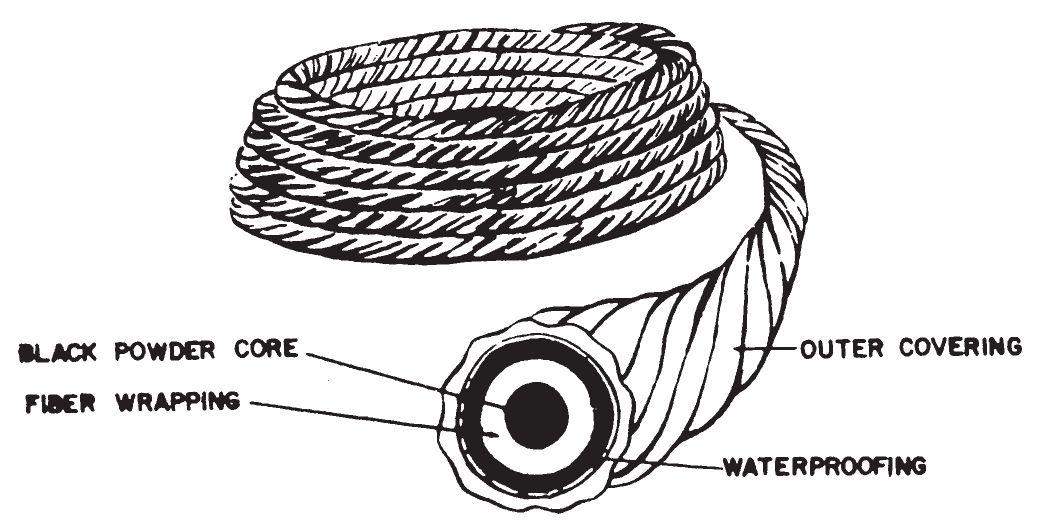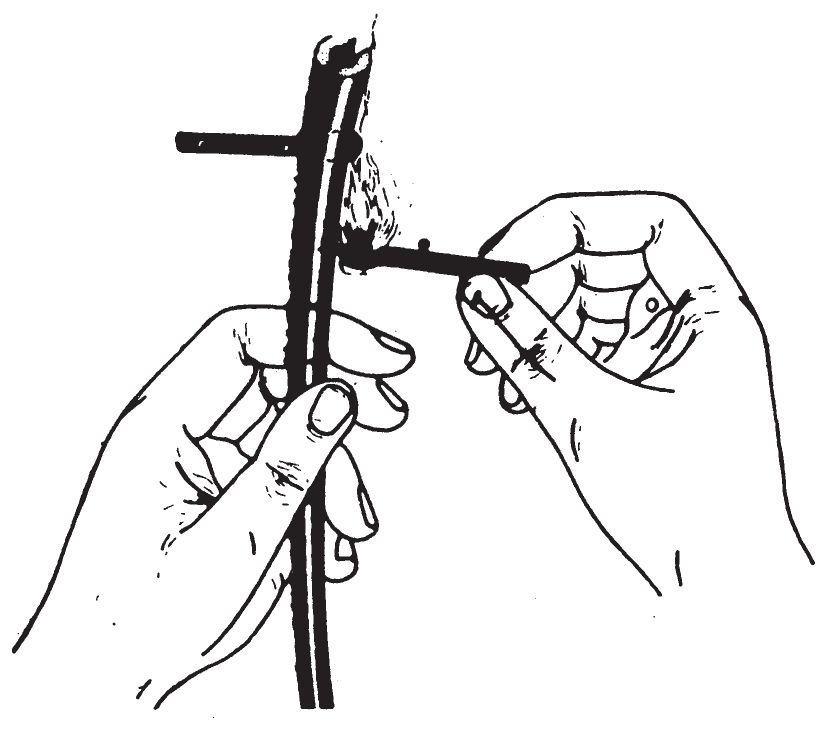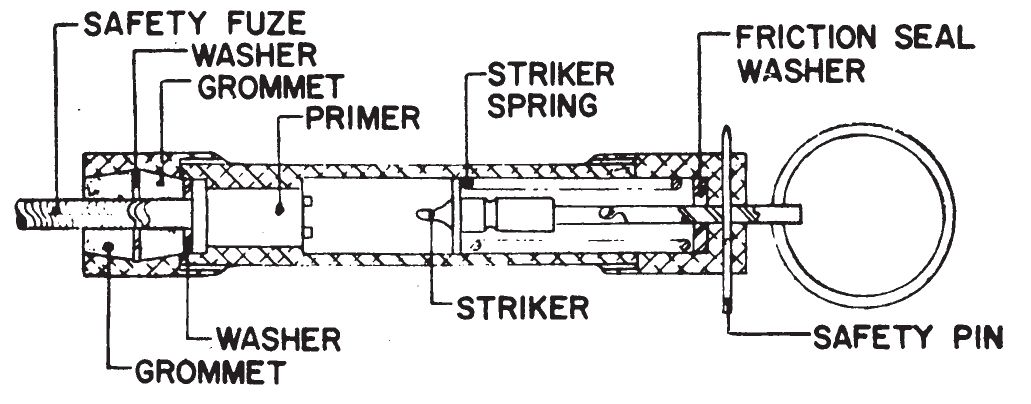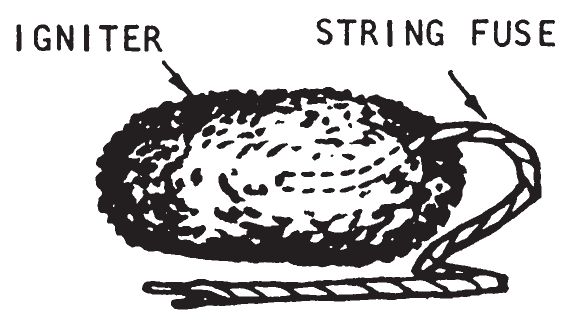Read U.S. Army Special Forces Guide to Unconventional Warfare Online
Authors: Department of the Army
U.S. Army Special Forces Guide to Unconventional Warfare (2 page)

INITIATORS
a. Description.
- This item consists of a continuous train of explosive or fastburning material enclosed in a flexible waterproof cord or cable. It is used for setting off an explosive or a combustible mixture of pow ders by action of the fuse flame on the material to be ignited. Fuse cord can be initiated by a match flame, using a specific procedure, or with a standard U.S. Army fuse lighter. Fuse cord burns at a uniform rate allowing the user to be away from the immediate scene when the incendiary actually functions.
- Fuse cord does not directly ignite any incendiaries listed in chapter 4 but is a primary initiator for all igniters listed in chapter 3 except: Potassium PermanganateâGlycer in (0206), Powdered AluminumâSulfur Pellets (0207), White Phosphorus (0209), and Subigniter For Thermite (0211).
b
.
Material and Equipment.
Two Standard U.S. Army fuse cords are available:
- Blasting time fuse.

This consists of black powder tightly wrapped with several layers of fabric and waterproofing materials. It might be any color, orange being the most common. The diameter of this fuse cord is 0.2 inch (a little larger than
 inch). This fuse burns inside the wrapping at a rate of approximately 40 seconds per foot. It must be tested before use to verify the burning rate.
inch). This fuse burns inside the wrapping at a rate of approximately 40 seconds per foot. It must be tested before use to verify the burning rate. - Safety fuse M700.

This fuse is similar to Blasting Time Fuse and may be used interchangeably with it. The fuse is a dark green cord 0.2 inch in diameter with a plastic cover, either smooth or with single painted abrasive bands around the outside at 1 foot or 18 inch intervals and double painted abrasive bands at 5 foot or 90 inch intervals depending on the time of manufacture. These bands are provided to make measuring easy. They are abrasive so that they can be felt in the dark. The fuse burns inside the wrapping at a rate of approximately 40 seconds per foot. It must be tested before use to verify the burning rate.
Note.
A commercial item can be substituted for either of the above U.S. Army issue items. The commercial fuse is 0.1 inch (about inch) in diameter and is coated only with waterproofing lacquer. This fuse can be easily ignited by holding the free end in a match flame because the outside covering if flammable.
inch) in diameter and is coated only with waterproofing lacquer. This fuse can be easily ignited by holding the free end in a match flame because the outside covering if flammable.
c. Preparation. None.
d. Application.
- General.
- (
a
) Cut and discard a 6-inch length from the free end of the fuse roll. Do this to be sure that there is no chance of misfire from a damp powder train because of absorption of moisture from the open air. Then cut off a measured length of fuze to check the burning rate. Check the burning rate before actual use. - (
b
) Cut the fuse long enough to allow a reasonable time delay in initiation of the incendiary system. The cut should be made squarely across the fuse. - (
c
) Prepare the fuse for ignition by splitting the fuse at one end to a depth of about one inch. Place the head of an unlighted match in the powder train. - (
d
) Insert the other end of the fuse into a quantity of an igniter mixture so that the fuse end terminates near the center of the mixture. Be sure the fuse cord is anchored in the igniter mixture and cannot pull away, In the case of a solid igniter material such as Fire Fudge (0202), the fuse is split to about one-half inch at the end opposite the end containing the match in the powder train. This split fuse end is wedged over a sharp edge of the solid igniter material. Be sure the black powder in the fuse firmly contacts the solid igniter. If necessary, the fuse cord can be held firmly to the solid igniter with light tape such as transparent adhesive tape. - (
e
) The fuse is initiated by lighting the match head inserted in the split end of the fuse with a burning match as shown below.
- (
f
) Two standard fuse lighters, the M2 and M60, are available in demolition kits for positive lighting of Blasting Time Fuse and Safety Fuse M700 under all weather conditionsâeven under water if it is properly waterproofed. The devices are manually operated. A pull on the striker retaining pin causes the striker to hit the percussion primer, thus igniting the fuse.
These devices are not recommended where silence is required because a report is heard when the primer is fired.
- (
- M2 fuse lighter.

The attachment and operation of the M2 Fuse Lighter are as follows:
- (
a
) Slide the pronged fuse retainer over the end of the fuse and firmly seat it. - (
b
) Waterproof the joint between the fuse and the lighter, if necessary, by applying a sealing compound (putty or mastic). - (
c
) In firing, hold the barrel in one hand and pull on the release pin with the other hand.
- (
- M60 fuse lighter.

The attachment and operation of the M60 Fuse Lighter are as follows:
- (
a
) Unscrew the fuse holder cap two or three turns. - (
b
) Press the shipping plug into the lighter to release the split grommet, and rotate the plug as it is removed. - (
c
) Insert end of fuse in place of the plug until it rests against the primer. - (
d
) Tighten the fuse holder cap sufficiently to hold the fuse tightly in place and thus waterproof the joint. - (
e
) To fire, remove the safety pin, hold the barrel in one hand, and pull on the pull ring with the other hand.
- (
a. Description.

- This item consists of string, twine, or shoelaces that have been treated with either a mixture of potassium nitrate and granulated sugar or potassium chlorate and granulated sugar.
- Improvised string fuse does not directly ignite any incendiaries listed in chapter 4 but is a primary initiator for all igniters listed in chapter 3 except: Potassium Permanganate âGlycerin (0206), Powdered Aluminumâ Sulfur Pellets (0207), White Phosphorus (0209), and Subigniter For Thermite (0211).
- Depending upon the length of the fuse, the user can be away from the immediate scene when an incendiary system is initiated.
b. Material and Equipment
.
String, twine or shoelaces made of cotton or linen.
Potassium nitrate or potassium chlorate.
Granulated sugar.
Small cooking pot.
Spoon.
Heat source such as stove or hot plate.
Soap.
c
.
Preparation
.
- Wash string or shoelaces in hot soapy water; rinse in fresh water.
- Dissolve one part potassium nitrate or potassium chlorate and one part granulated sugar in two parts hot water.
- Soak string or shoelaces in the hot solution for at least five minutes.
- Remove the string from hot solution and twist or braid three strands of string together.
- Hang the fuse up to dry.
- Check actual burning rate of the fuse by measuring the time it takes for a known length to burn.
d. Application.
- This fuse does not have a waterproof coating and it must be tested by burning a measured length before actual use.
- Cut the fuse long enough to allow a reasonable time delay in initiation of the incendiary system.
- Insert one end of the fuse in a quantity of an igniter mixture so that the fuse end terminates near the center of the mixture. Be sure the fuse cord is anchored in the igniter mixture and cannot pull away. In the case of a solid igniter material such as Fire Fudge (0202), the improvised string fuse is securely wrapped around a piece of solid igniter material.
- The fuse is initiated by lighting the free end of the fuse with a match.
- This fuse does not burn when it is wet. Its use is not recommended where there is the possibility of the fuse getting wet.
